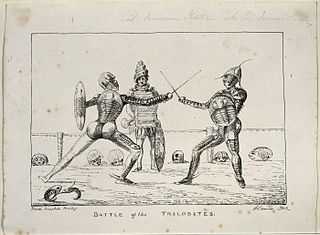Levett Landon Boscawen Ibbetson

Captain Levett Landon Boscawen Ibbetson[1] (1799 – 8 September 1869) was an English 19th century geologist, inventor, organiser and soldier. He is particularly associated with early developments in photography, and was a Fellow of the Royal Society (elected 6 June 1850).[2][3]
From his London home (46 Margaret Street, near Cavendish Square),[4] Ibbetson corresponded with William Henry Fox Talbot in 1842,[5] having spent some years trying to produce a lithograph from an original daguerrotype, writing "I have been going on with experiments in the Callotype & have had some very good results as to depth of Colour." Ten years later, in 1852, Ibbetson exhibited work produced using the Talbot calotype process, called Le Premier Livre Imprimè par le Soleil, at a London Society of Arts exhibition.[6] This book, originally published in 1840, was an album of contact prints of ferns, grasses and flowers and used "the independently invented process of Friedrich Gerber of Berne, published in January 1839, when Ibbetson was residing in Berne."[7]
An enthusiastic geologist, one of Ibbetson's finds on the Isle of Wight, the fossilised remains of a Hybodus, was sent to Sir Philip Malpas de Grey Egerton, and was discussed in the Proceedings of the Geological Society in 1845.[8]
During the 1840s, Ibbetson was also engaged in various geological surveys associated with the expansion of the British railway system, during which work he corresponded with eminent geologist Henry Thomas De la Beche.[9]
He wrote a book, with contributions from Edwin Lankester, published around 1852, entitled Notes on the geology and chemical composition of the various strata in the Isle of Wight ... With a map in relief.[10] With Professor Edward Forbes, he produced a description of the geology between Blackgang Chine and Atherfield Point, in the Isle of Wight, for the Geological Society.[11]
In 1851, Levett Ibbetson helped manage the Great Exhibition. At this event, public toilets were relatively novel, and Ibbetson was given the task of writing an 'Official Report On The Waiting Rooms and Washing Places in the Exhibition Building' - during which he recorded "The largest receipt from the Waiting Rooms was on Wednesday, 8 October 1851 when 11,171 persons made use of them".[12]
Ibbetson died at Biebrich in Prussia, where he had lived for several years. Some years earlier he presented a valuable collection of fossils to the Museum of Practical Geology in London.[11]

Capt. Levett Landon Boscawen Ibbetson was the father of Major Henry Levett Boscawen Ibbetson of the 77th (East Middlesex) Regiment of Foot of the British Army.[13] Capt. Levett Landon Boscawen Ibbetson was the son of Sophy and Major Levett Ibbetson, a native of Bushey, Hertfordshire, where his father the Right Rev. Dr. James Ibbetson, D.D.[14] (1717–1781), was the rector of Bushey, the Archdeacon of St Albans and Prebend of Lincoln as well as an author.[15][16] Major Levett, his son, was a soldier in the 28th (North Gloucestershire) Regiment of Foot of the British Army.[17] Major Levett Ibbetson lived at West Teignmouth, Devon, England.
References
- ↑ Ibbetson's name was frequently spelled Levett Landen Boscawen Ibbetson.
- ↑ http://royalsociety.org/downloaddoc.asp?id=4274
- ↑ "Anniversary Meeting". Proceedings of the Royal Society of London 18 (114–122): 101–115. 1869. doi:10.1098/rspl.1869.0030. JSTOR 112723.
- ↑ Ibbetson later lived at Clifton House, Old Brompton Road, London.
- ↑ "Talbot Correspondence Project: IBBETSON Levett Landon Boscawen to TALBOT William Henry Fox". Foxtalbot.dmu.ac.uk. Retrieved 2008-11-21.
- ↑ "Exhibit: Le Premier Livre Imprimè par le Soleil". Peib.dmu.ac.uk. Retrieved 2008-11-21.
- ↑ Helmut Gernsheim (1984), Incunabula of British Photographic Literature (London: Scholar Press), p.16; cited by Geoffrey Batchen (1999), Burning with Desire: The Conception of Photography (Boston: MIT Press), p.47
- ↑ Egerton, P. M. d. G. (1845). "Description of the Mouth of a Hybodus found by Mr. Boscawen Ibbetson in the Isle of Wight". Quarterly Journal of the Geological Society 1: 197. doi:10.1144/GSL.JGS.1845.001.01.51.
- ↑ Sharpe, T. & McCartney, P.J. (1998) The papers of H. T. De la Beche (1796 - 1855) in the National Museum of Wales (Cardiff: National Museum Wales Books).
- ↑ "Athenaeum Title Record". Athenaeum.soi.city.ac.uk. Retrieved 2008-11-21.
- ↑ 11.0 11.1 "Address of the President of the Geological Society 1870". Aleph0.clarku.edu. Retrieved 2008-11-21.
- ↑ "A Day At The Great Exhibition - Victoria and Albert Museum". Vam.ac.uk. Retrieved 2008-11-21.
- ↑ Colburn's United Service Magazine and Naval and Military Journal, Part II, Hurst and Blackett, London, 1876
- ↑ The Right Rev. Dr. James Ibbetson was the son of Ebenezer Ibbetson, born to a trading family at Leeds, Yorkshire, who became a London salter and founder of a textile firm in 1727. Ebenezer Ibbetson married Catherine Levett, the daughter of Francis Levett, who operated the trading firm Sir Richard Levett & Co., along with his brother Sir Richard Levett, Lord Mayor of London. Several family members went into the family textile business, including Ebenezer's son John Ibbetson, who became a factor at Livorno, Italy.
- ↑ Notes and Queries, Fourth Series, Vol. 5, Oxford University Press, 1870
- ↑ Ibbetson, James (1717–1781), Papers (1746–1775), Pitts Theology Library, Archives and Manuscript Department, Emory University
- ↑ Annual Register, Vol. 45, Edmund Burke, London, 1805
Works by L. L. Boscawen Ibbetson
- On the Tertiary and Cretaceous Formations of the Isle of Wight, co-authored with Prof. E. Forbes, 1844
- Notes on the Geology and Chemical Composition of the various Strata in the Isle of Wight, J. Van Voorst, London, 1849